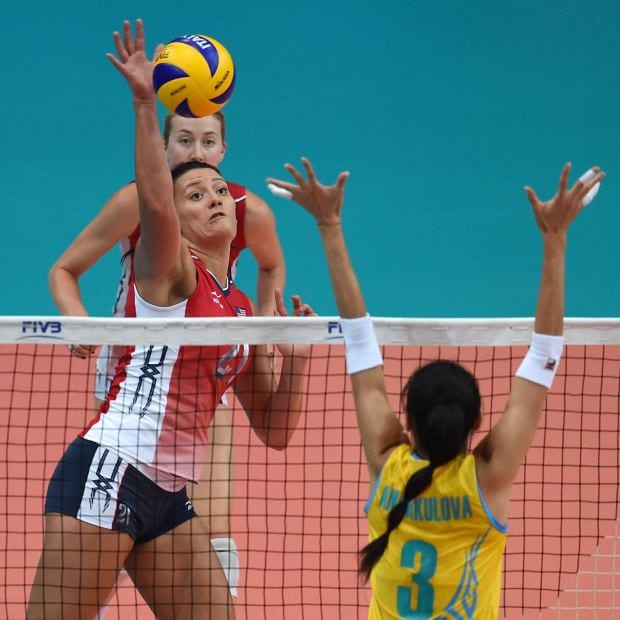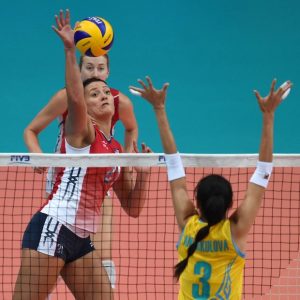
18 Nov Volleyball Knee Injuries- Key USA Volleyball Prevention and Rehabilitation Tips
USA Volleyball athletes and medical experts aren’t afraid to pass on key tips on preventing and rehabilitating volleyball knee injuries.
"For a knee injury, it's important to rehab & focus on hips, glutes, quads & hamstrings" @ToriDixon06 +pros on: https://t.co/AD08fq0Whf pic.twitter.com/JpNSD5AMvt
— USA Volleyball (@usavolleyball) November 4, 2017
-
Click on video above to hear key pearls on volleyball injuries and recovery
-
Related Content: Click here for full article: Injuries and recovery: USA Volleyball athletes give insights on their approach
Right on, Tori Dixon– keeping knees healthy requires focus on several supporting muscle groups.
- The gluteal muscles in the back of hips help prevent abnormal knee collapse or rotation with landing
- The hip adductor (bring thighs together) and abductor (bring thighs apart) muscles support single leg activity such as jumping
- The quadriceps and hamstring muscles in the front and back of the thigh also help control knee motion
- Calf muscles in the lower leg take pressure off knees by controlling motion when landing from a jump (especially in sand volleyball)
- Having these muscle groups work in a coordinated fashion is essential to keep knees healthy
Volleyball Knee Injuries: what are 5 tips for healthy knees?
Avoid landing on straight knees. Always land and move “softly”
with hips, knees and ankles bent.
Try to land in good alignment, with the hips and knees lined up
with the second toe. Don’t let your knees collapse in or rotate.
The best time to stretch is after practice or after a match when the
muscles are warm. Focus on hamstrings, quadriceps, hip adductors/abductors
and calf muscles.
Don’t hesitate to ice sore knees for 20 minutes after practices
or matches.
Knee pads help reduce bruises and pounding, especially
with repetitive diving drills.
These above tips are part of the article: Joint Effort written by Eric Hammond for VolleyballUSA. Eric quotes me and Jill Wosmek, MA, ATC now former head athletic trainer for the USA Volleyball Women’s National Team. A very comprehensive article on the importance of protecting the knees to not only stay on the court, but also to reduce fatigue and perform better.
- Have to give a shout out (as did Tori above) to Tim Pelot and Jimmy Stitz, Sport Physiologists and Strength and Conditioning Coaches for USA Volleyball for their masterful approaches to building healthier knees and volleyball players.
-
Related Content: Watch my video below on proper landing technique to reduce serious volleyball knee injuries
When and how should you stretch to prevent volleyball knee injuries?
Per Aaron Brock, MS, ATC, Director of Sports Medicine and Performance and Athletic Trainer for the USA Volleyball Men’s National Team.
I encourage two bouts of static stretching during a training session:
The first bout should be no more than five minutes long and take place after a dynamic warm up such as jogging, side shuffling, skipping, backwards running, plyometrics, agility drills, ladder drills, etc. This stretch should focus on your problematic areas as opposed to a full drawn out stretch on every possible muscle group.
However, if you feel better with a long, complete stretch prior to activity, then stick with it.
The second bout of stretching should occur immediately following your volleyball activity. The Men’s Olympic Volleyball Team takes about 10 minutes to stretch all pertinent muscles groups including hip flexors, hamstrings, claves, glutes, quads, adductors/groin, abdomen, low back and shoulders with extra focus on individual problematic areas after each practice and every game.
Click here for Aarons top 10 stretches to reduce volleyball knee injuries (and other volleyball injuries)
Related Content: My video on the Top 6 Volleyball injuries (including Volleyball Knee Injuries)
